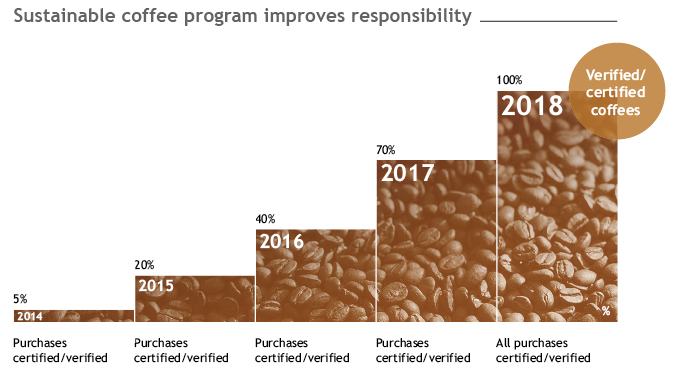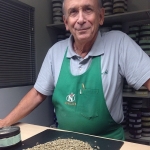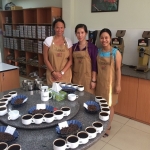A reliable network of partners builds responsibility
Sourcing
An essential part of Paulig's responsibility involves procurement, which embraces the raw materials, products and services bought in by Paulig. Green coffee constitutes the bulk of procurements; each year Paulig purchases a total of roughly 900,000 bags (60 kg each) of green coffee in different parts of the world.

One of the goals of the Sustainable Coffee programme, which was launched in 2013, is for all of Paulig's purchases of green coffee to be responsibly produced by the end of 2018. In practice, this means focusing purchases on responsibility-certified and verified coffee. The changeover will take place in stages during the period 2015─2018. The aim in the course of the programme is to expand the share of these coffees in procurement in the following steps: 20% (2015), 40% (2016), 70% (2017), 100% (2018). In 2014, roughly 6% of the coffee purchased by Paulig was certified. The certifications we use are Fairtrade, UTZ Certified and Organic. We also use 4C verification in our procurement.
Traceability creates transparency
Procurement has promoted the traceability of coffee actively for the past ten years in cooperation with coffee suppliers operating in the countries of origin in which Paulig buys green coffee. A traceability study based on samplings of green coffee purchases is carried out at Paulig annually. You can find the latest results here. In almost all of the countries of origin, green coffee can already be traced from the export agency one step closer to the grower, and in some the plantation level is reached. For example, roughly half of the coffee coming from Brazil can already be traced to the plantation where it was grown. In a few countries of origin, including Ethiopia and Kenya, the coffee trade's supply chains and customs make it almost impossible to trace back to the plantations. The coffee plantations are small and the coffee is sold on a centralised basis at state-supervised auctions.
 Collaboration between Paulig and its partners is long-sighted. A stable chain of partners is also important in promoting practical responsibility work. A large percentage of coffee purchases is made direct from the countries of origin, and the specialists in charge of Paulig's procurement visit these countries regularly. Visits to the coffee plantations and processing plants are an important part of the collaboration and they provide information on operational requirements and operating methods in the countries of origin. This information is utilised in assessing potential output, quality, risks and responsibility. The Paulig Group Code of Conduct for Suppliers (pdf) specifies the principles for responsible operation, and all raw material suppliers are required to comply with these principles in their own operations.
Collaboration between Paulig and its partners is long-sighted. A stable chain of partners is also important in promoting practical responsibility work. A large percentage of coffee purchases is made direct from the countries of origin, and the specialists in charge of Paulig's procurement visit these countries regularly. Visits to the coffee plantations and processing plants are an important part of the collaboration and they provide information on operational requirements and operating methods in the countries of origin. This information is utilised in assessing potential output, quality, risks and responsibility. The Paulig Group Code of Conduct for Suppliers (pdf) specifies the principles for responsible operation, and all raw material suppliers are required to comply with these principles in their own operations.
In 2014, procurement focused particularly on responsibility themes by preparing for the implementation of the Sustainable Coffee programme and by participating in the Paulig Group's common Responsible Sourcing project. This was the framework for creating a common procedure for the entire Paulig Group as well as tools to enable the recognition of the social and environmental risks of our supply chain and to tackle problems. The project included, for example, a preliminary risk survey of suppliers and an update to the Paulig Group Code of Conduct for Suppliers. All high-risk suppliers next receive a questionnaire to determine the consistency of the suppliers' responsibility procedures, both within the company and in the sub-procurement chain. The responses are used to determine the necessary follow-up procedures, which include an in-depth questionnaire and various levels of auditing.
In negotiations with suppliers, aspects of responsibility have been clearly made a part of partnership and operational development.
The price of green coffee continued to fluctuate
The price of green coffee rose sharply in the early months of 2014. The spike in prices was due primarily to severe drought in Brazil's coffee regions. On the New York coffee exchanges, the price peaked at roughly 230 US cents/lb. The rise in the rice of raw material was also felt in consumer prices in the late spring. In October, the price of coffee went into a downturn again when the impacts of the Brazilian drought were forecast to be smaller than expected and investors pulled out of the coffee market. In mid-March 2015, the price was 136 US cents/lb.
 The price of green coffee has been affected in recent years not only by weather conditions but also by uncertainty in the stock market and by rapid fluctuations in currency exchange rates, last year particularly by the weakening of the euro against the US dollar. Also, changes in developing coffee-producing regions and in new coffee-consuming countries affect demand and supply for green coffee, at the same time influencing the price.
The price of green coffee has been affected in recent years not only by weather conditions but also by uncertainty in the stock market and by rapid fluctuations in currency exchange rates, last year particularly by the weakening of the euro against the US dollar. Also, changes in developing coffee-producing regions and in new coffee-consuming countries affect demand and supply for green coffee, at the same time influencing the price.
The price trend is also meaningful from the perspective of responsibility. A price level that guarantees profitability gives the grower a better income and facilitates the maintenance and improvement of the plantation and its future prospects. This is important for the availability and quality of green coffee, also in the future. Most of the world's coffee plantations are very small, averaging less than two hectares, and the threshold for growers to switch to alternative, more profitable crops may be lowered if the price obtained for coffee is not attractive.
The profitability of coffee cultivation and the growers' everyday lives are also increasingly affected by climate change. In order to manage the impacts, Paulig takes part in the international Coffee & Climate programme, among others. This provides growers with practical advice and tools for preventing things like soil desiccation and flood damage.
